SENG205 Software Engineering: Design of a Medical Health Record System
VerifiedAdded on 2023/04/04
|18
|2596
|479
Report
AI Summary
This report outlines the development of a new medical health record system proposed by the Australian government, designed to provide registered healthcare professionals with easy access to patient health records. A portion of these records will be available to insurance providers to facilitate better insurance packages. The report covers detail requirements, requirement analysis using techniques like BPMN, UML, flowcharts, and DFD, and analytical hierarchical process along with use case, data flow, and entity-relationship diagrams. The database design is presented, followed by a discussion of the waterfall model for software development and UI design considerations for data security. Functional and non-functional requirements are specified, culminating in recommendations for the new system. Desklib provides access to similar assignments and resources for students.
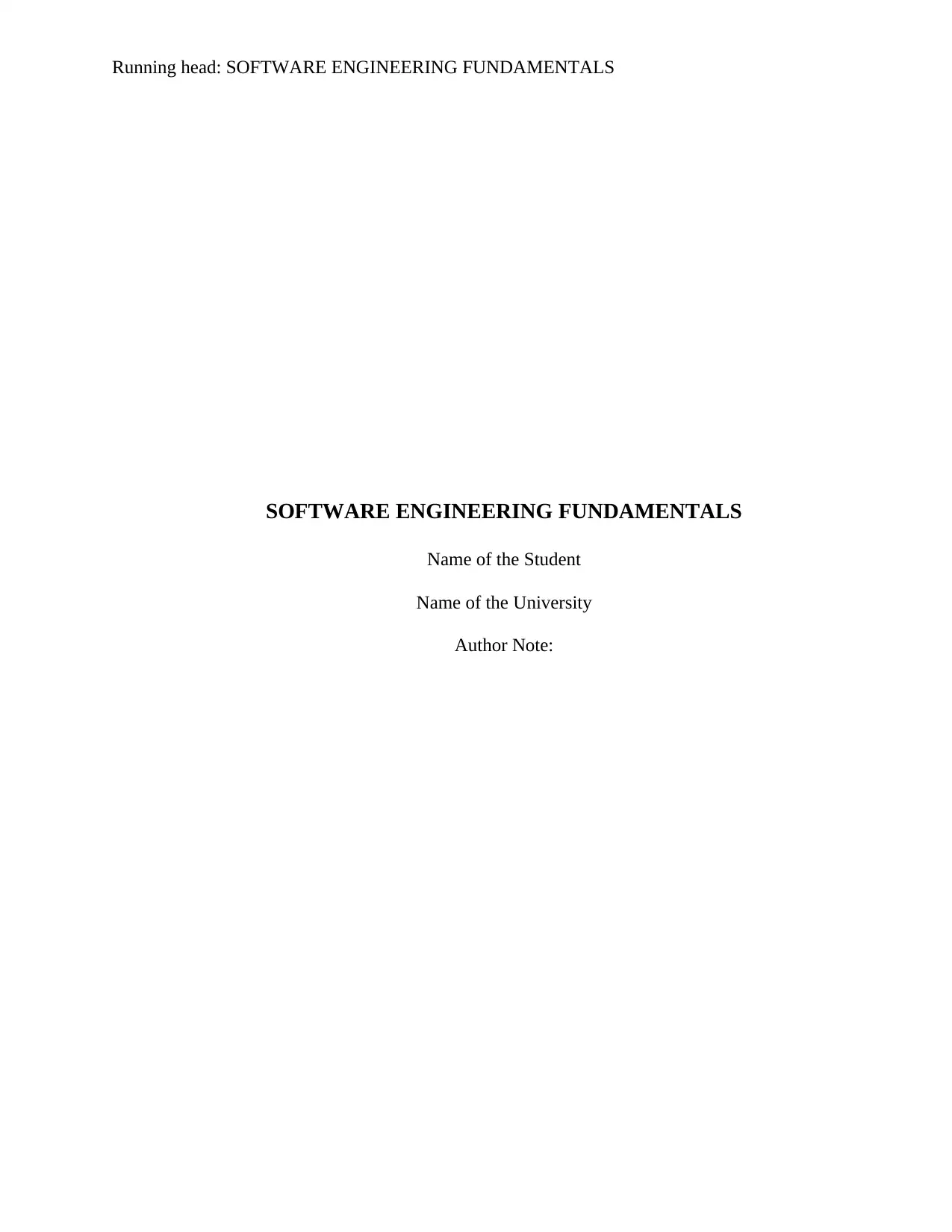
Running head: SOFTWARE ENGINEERING FUNDAMENTALS
SOFTWARE ENGINEERING FUNDAMENTALS
Name of the Student
Name of the University
Author Note:
SOFTWARE ENGINEERING FUNDAMENTALS
Name of the Student
Name of the University
Author Note:
Paraphrase This Document
Need a fresh take? Get an instant paraphrase of this document with our AI Paraphraser
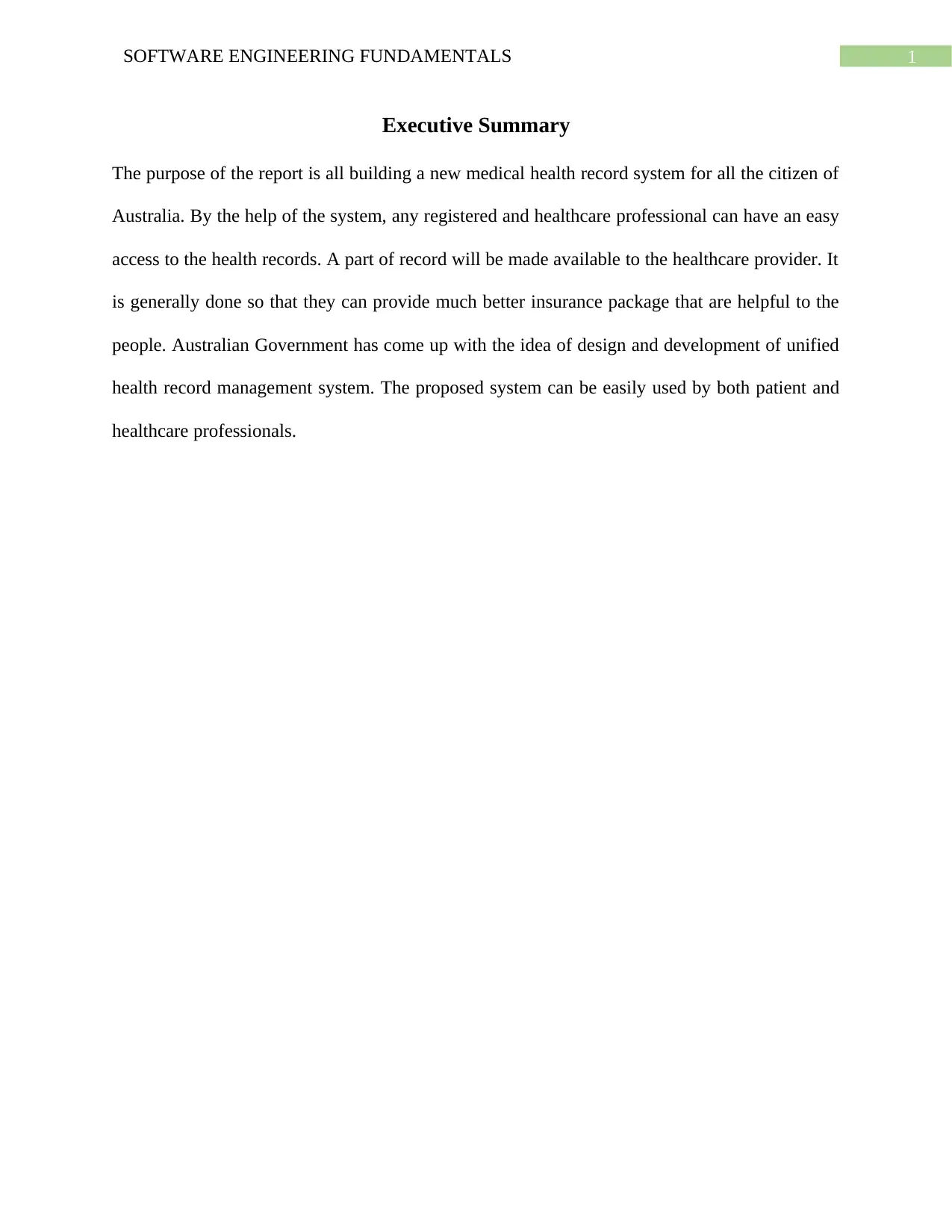
1SOFTWARE ENGINEERING FUNDAMENTALS
Executive Summary
The purpose of the report is all building a new medical health record system for all the citizen of
Australia. By the help of the system, any registered and healthcare professional can have an easy
access to the health records. A part of record will be made available to the healthcare provider. It
is generally done so that they can provide much better insurance package that are helpful to the
people. Australian Government has come up with the idea of design and development of unified
health record management system. The proposed system can be easily used by both patient and
healthcare professionals.
Executive Summary
The purpose of the report is all building a new medical health record system for all the citizen of
Australia. By the help of the system, any registered and healthcare professional can have an easy
access to the health records. A part of record will be made available to the healthcare provider. It
is generally done so that they can provide much better insurance package that are helpful to the
people. Australian Government has come up with the idea of design and development of unified
health record management system. The proposed system can be easily used by both patient and
healthcare professionals.
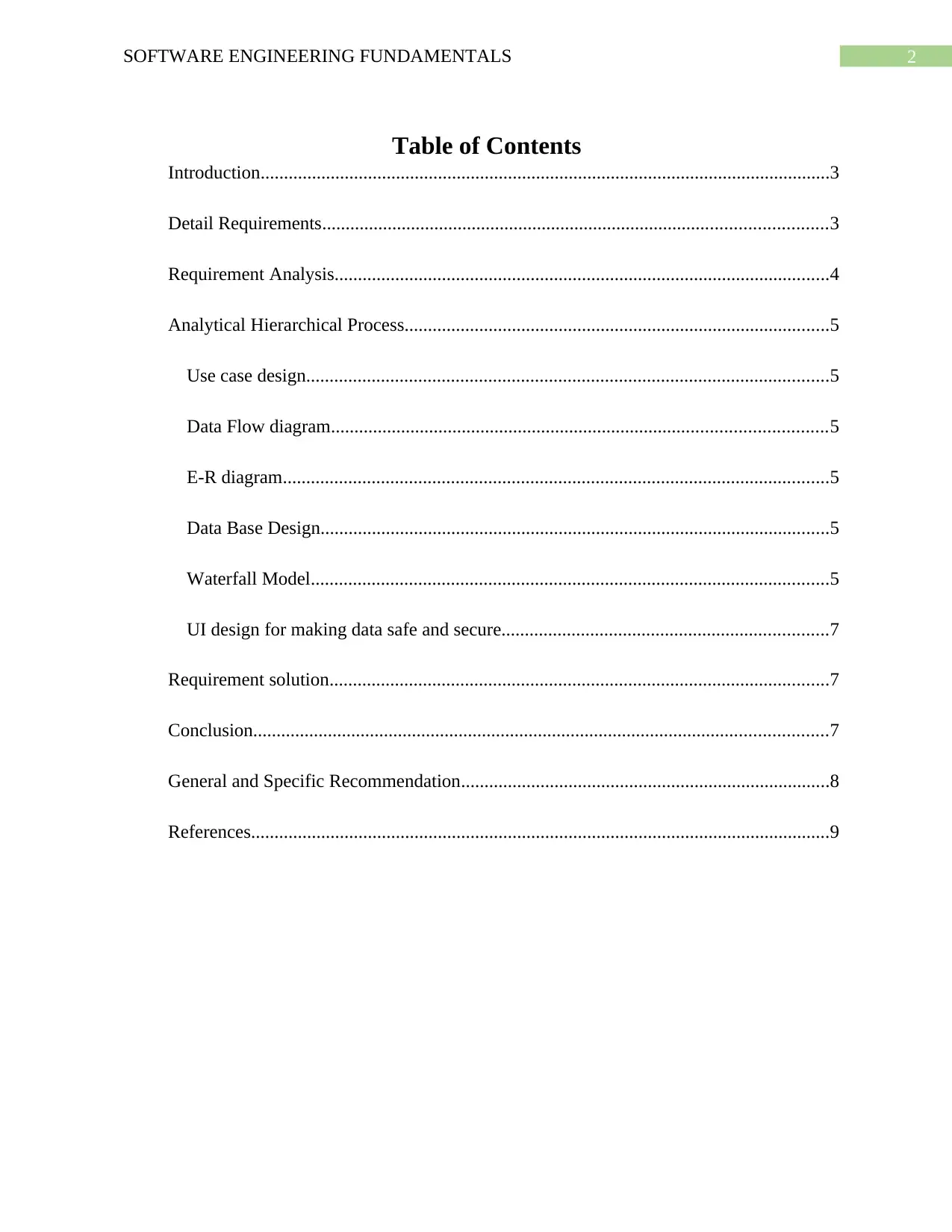
2SOFTWARE ENGINEERING FUNDAMENTALS
Table of Contents
Introduction..........................................................................................................................3
Detail Requirements............................................................................................................3
Requirement Analysis..........................................................................................................4
Analytical Hierarchical Process...........................................................................................5
Use case design................................................................................................................5
Data Flow diagram..........................................................................................................5
E-R diagram.....................................................................................................................5
Data Base Design.............................................................................................................5
Waterfall Model...............................................................................................................5
UI design for making data safe and secure......................................................................7
Requirement solution...........................................................................................................7
Conclusion...........................................................................................................................7
General and Specific Recommendation...............................................................................8
References............................................................................................................................9
Table of Contents
Introduction..........................................................................................................................3
Detail Requirements............................................................................................................3
Requirement Analysis..........................................................................................................4
Analytical Hierarchical Process...........................................................................................5
Use case design................................................................................................................5
Data Flow diagram..........................................................................................................5
E-R diagram.....................................................................................................................5
Data Base Design.............................................................................................................5
Waterfall Model...............................................................................................................5
UI design for making data safe and secure......................................................................7
Requirement solution...........................................................................................................7
Conclusion...........................................................................................................................7
General and Specific Recommendation...............................................................................8
References............................................................................................................................9
⊘ This is a preview!⊘
Do you want full access?
Subscribe today to unlock all pages.

Trusted by 1+ million students worldwide
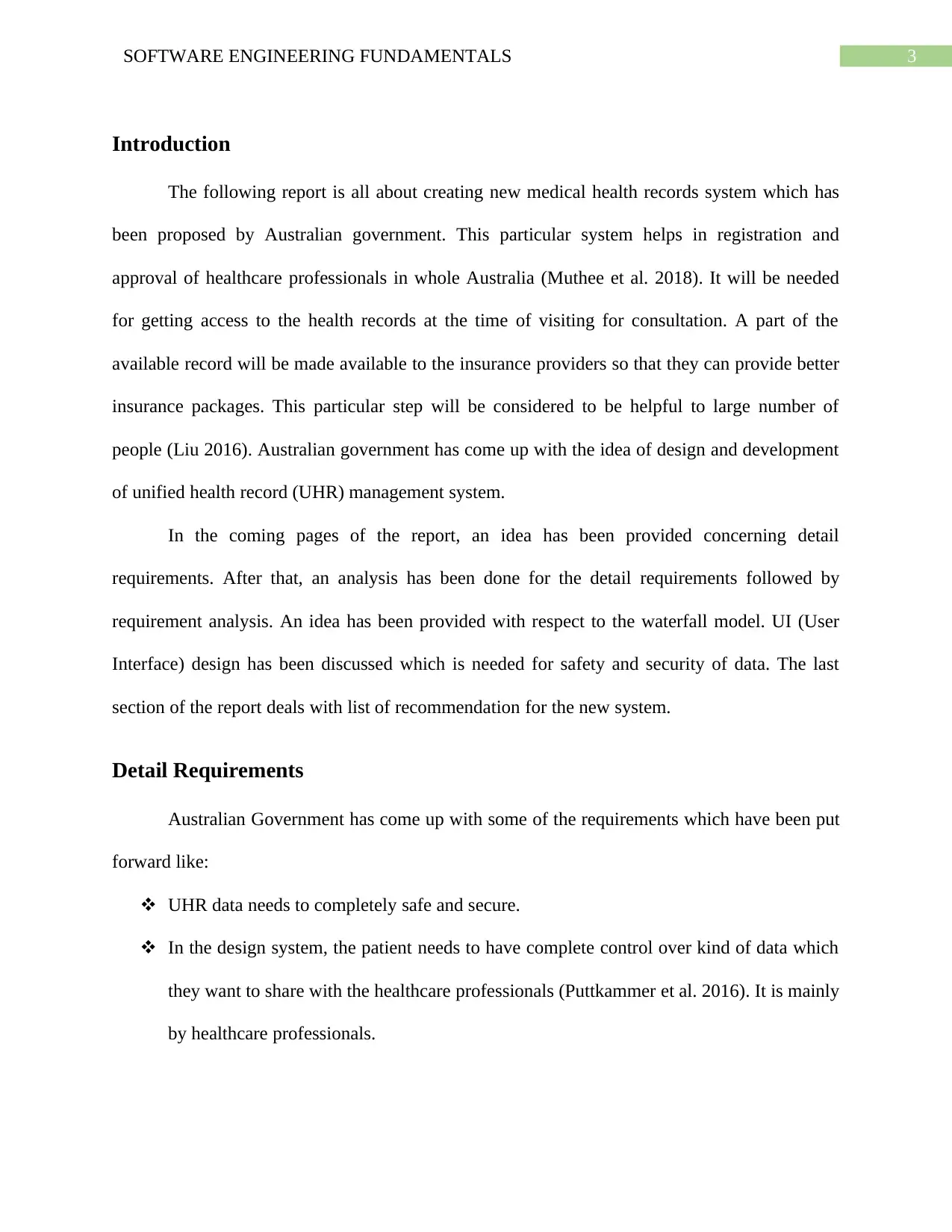
3SOFTWARE ENGINEERING FUNDAMENTALS
Introduction
The following report is all about creating new medical health records system which has
been proposed by Australian government. This particular system helps in registration and
approval of healthcare professionals in whole Australia (Muthee et al. 2018). It will be needed
for getting access to the health records at the time of visiting for consultation. A part of the
available record will be made available to the insurance providers so that they can provide better
insurance packages. This particular step will be considered to be helpful to large number of
people (Liu 2016). Australian government has come up with the idea of design and development
of unified health record (UHR) management system.
In the coming pages of the report, an idea has been provided concerning detail
requirements. After that, an analysis has been done for the detail requirements followed by
requirement analysis. An idea has been provided with respect to the waterfall model. UI (User
Interface) design has been discussed which is needed for safety and security of data. The last
section of the report deals with list of recommendation for the new system.
Detail Requirements
Australian Government has come up with some of the requirements which have been put
forward like:
UHR data needs to completely safe and secure.
In the design system, the patient needs to have complete control over kind of data which
they want to share with the healthcare professionals (Puttkammer et al. 2016). It is mainly
by healthcare professionals.
Introduction
The following report is all about creating new medical health records system which has
been proposed by Australian government. This particular system helps in registration and
approval of healthcare professionals in whole Australia (Muthee et al. 2018). It will be needed
for getting access to the health records at the time of visiting for consultation. A part of the
available record will be made available to the insurance providers so that they can provide better
insurance packages. This particular step will be considered to be helpful to large number of
people (Liu 2016). Australian government has come up with the idea of design and development
of unified health record (UHR) management system.
In the coming pages of the report, an idea has been provided concerning detail
requirements. After that, an analysis has been done for the detail requirements followed by
requirement analysis. An idea has been provided with respect to the waterfall model. UI (User
Interface) design has been discussed which is needed for safety and security of data. The last
section of the report deals with list of recommendation for the new system.
Detail Requirements
Australian Government has come up with some of the requirements which have been put
forward like:
UHR data needs to completely safe and secure.
In the design system, the patient needs to have complete control over kind of data which
they want to share with the healthcare professionals (Puttkammer et al. 2016). It is mainly
by healthcare professionals.
Paraphrase This Document
Need a fresh take? Get an instant paraphrase of this document with our AI Paraphraser
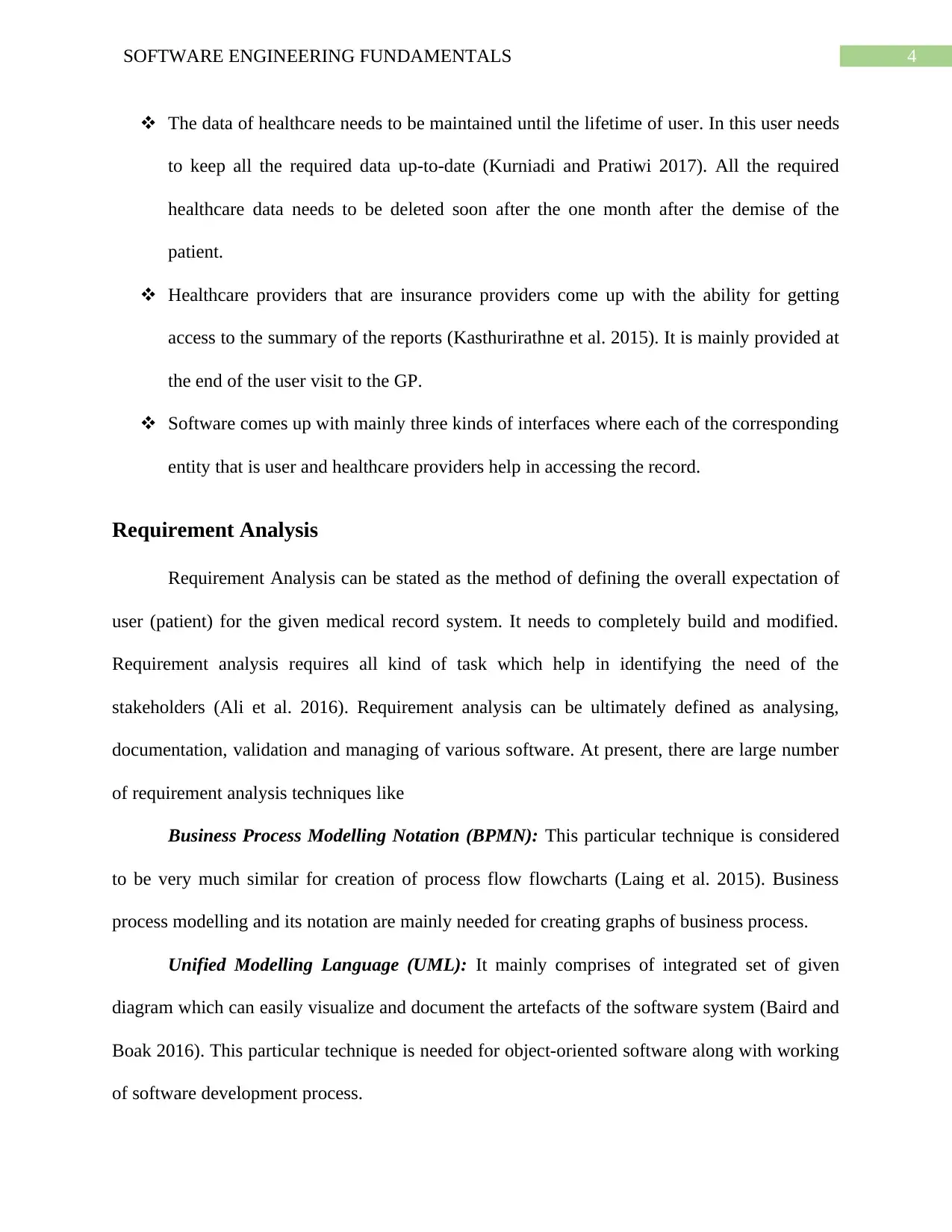
4SOFTWARE ENGINEERING FUNDAMENTALS
The data of healthcare needs to be maintained until the lifetime of user. In this user needs
to keep all the required data up-to-date (Kurniadi and Pratiwi 2017). All the required
healthcare data needs to be deleted soon after the one month after the demise of the
patient.
Healthcare providers that are insurance providers come up with the ability for getting
access to the summary of the reports (Kasthurirathne et al. 2015). It is mainly provided at
the end of the user visit to the GP.
Software comes up with mainly three kinds of interfaces where each of the corresponding
entity that is user and healthcare providers help in accessing the record.
Requirement Analysis
Requirement Analysis can be stated as the method of defining the overall expectation of
user (patient) for the given medical record system. It needs to completely build and modified.
Requirement analysis requires all kind of task which help in identifying the need of the
stakeholders (Ali et al. 2016). Requirement analysis can be ultimately defined as analysing,
documentation, validation and managing of various software. At present, there are large number
of requirement analysis techniques like
Business Process Modelling Notation (BPMN): This particular technique is considered
to be very much similar for creation of process flow flowcharts (Laing et al. 2015). Business
process modelling and its notation are mainly needed for creating graphs of business process.
Unified Modelling Language (UML): It mainly comprises of integrated set of given
diagram which can easily visualize and document the artefacts of the software system (Baird and
Boak 2016). This particular technique is needed for object-oriented software along with working
of software development process.
The data of healthcare needs to be maintained until the lifetime of user. In this user needs
to keep all the required data up-to-date (Kurniadi and Pratiwi 2017). All the required
healthcare data needs to be deleted soon after the one month after the demise of the
patient.
Healthcare providers that are insurance providers come up with the ability for getting
access to the summary of the reports (Kasthurirathne et al. 2015). It is mainly provided at
the end of the user visit to the GP.
Software comes up with mainly three kinds of interfaces where each of the corresponding
entity that is user and healthcare providers help in accessing the record.
Requirement Analysis
Requirement Analysis can be stated as the method of defining the overall expectation of
user (patient) for the given medical record system. It needs to completely build and modified.
Requirement analysis requires all kind of task which help in identifying the need of the
stakeholders (Ali et al. 2016). Requirement analysis can be ultimately defined as analysing,
documentation, validation and managing of various software. At present, there are large number
of requirement analysis techniques like
Business Process Modelling Notation (BPMN): This particular technique is considered
to be very much similar for creation of process flow flowcharts (Laing et al. 2015). Business
process modelling and its notation are mainly needed for creating graphs of business process.
Unified Modelling Language (UML): It mainly comprises of integrated set of given
diagram which can easily visualize and document the artefacts of the software system (Baird and
Boak 2016). This particular technique is needed for object-oriented software along with working
of software development process.
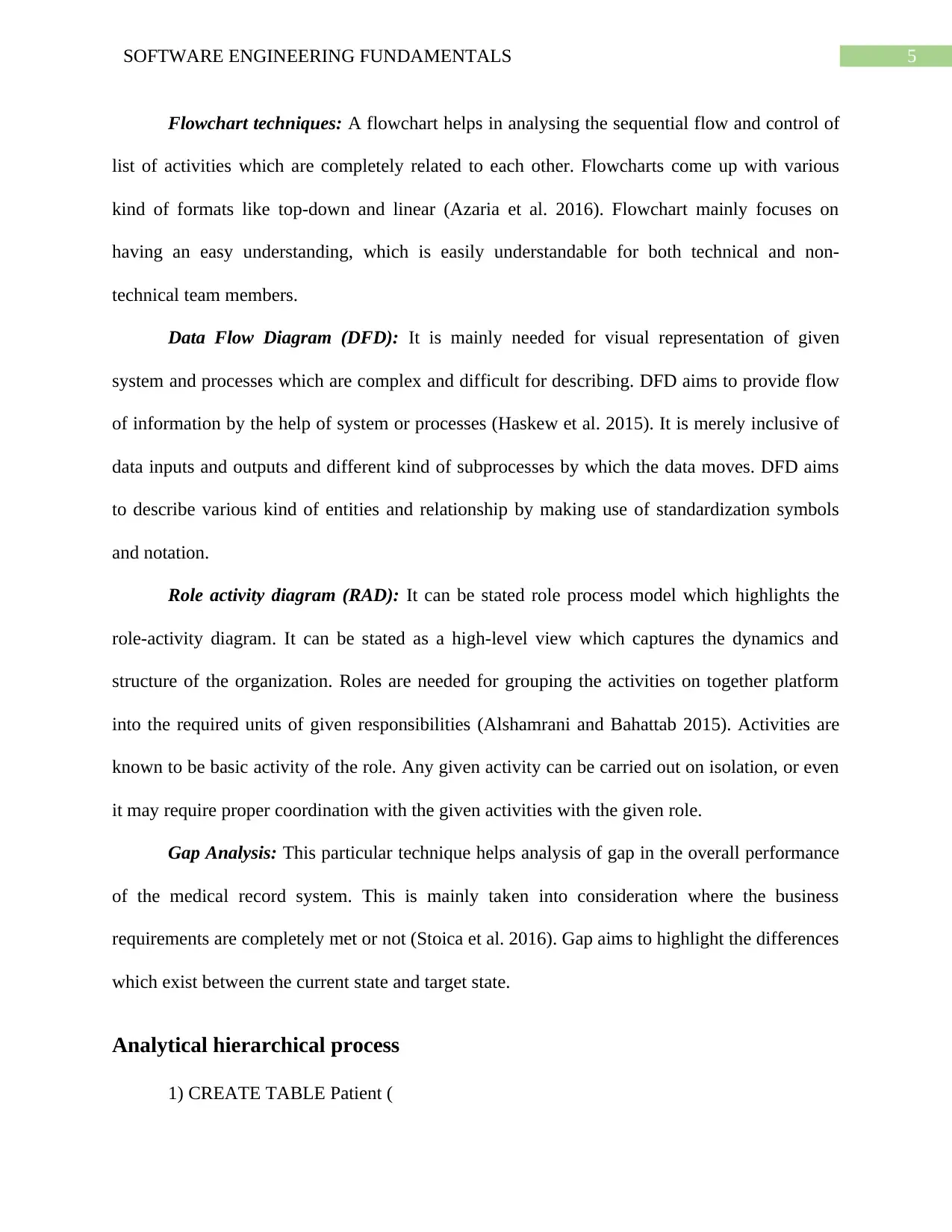
5SOFTWARE ENGINEERING FUNDAMENTALS
Flowchart techniques: A flowchart helps in analysing the sequential flow and control of
list of activities which are completely related to each other. Flowcharts come up with various
kind of formats like top-down and linear (Azaria et al. 2016). Flowchart mainly focuses on
having an easy understanding, which is easily understandable for both technical and non-
technical team members.
Data Flow Diagram (DFD): It is mainly needed for visual representation of given
system and processes which are complex and difficult for describing. DFD aims to provide flow
of information by the help of system or processes (Haskew et al. 2015). It is merely inclusive of
data inputs and outputs and different kind of subprocesses by which the data moves. DFD aims
to describe various kind of entities and relationship by making use of standardization symbols
and notation.
Role activity diagram (RAD): It can be stated role process model which highlights the
role-activity diagram. It can be stated as a high-level view which captures the dynamics and
structure of the organization. Roles are needed for grouping the activities on together platform
into the required units of given responsibilities (Alshamrani and Bahattab 2015). Activities are
known to be basic activity of the role. Any given activity can be carried out on isolation, or even
it may require proper coordination with the given activities with the given role.
Gap Analysis: This particular technique helps analysis of gap in the overall performance
of the medical record system. This is mainly taken into consideration where the business
requirements are completely met or not (Stoica et al. 2016). Gap aims to highlight the differences
which exist between the current state and target state.
Analytical hierarchical process
1) CREATE TABLE Patient (
Flowchart techniques: A flowchart helps in analysing the sequential flow and control of
list of activities which are completely related to each other. Flowcharts come up with various
kind of formats like top-down and linear (Azaria et al. 2016). Flowchart mainly focuses on
having an easy understanding, which is easily understandable for both technical and non-
technical team members.
Data Flow Diagram (DFD): It is mainly needed for visual representation of given
system and processes which are complex and difficult for describing. DFD aims to provide flow
of information by the help of system or processes (Haskew et al. 2015). It is merely inclusive of
data inputs and outputs and different kind of subprocesses by which the data moves. DFD aims
to describe various kind of entities and relationship by making use of standardization symbols
and notation.
Role activity diagram (RAD): It can be stated role process model which highlights the
role-activity diagram. It can be stated as a high-level view which captures the dynamics and
structure of the organization. Roles are needed for grouping the activities on together platform
into the required units of given responsibilities (Alshamrani and Bahattab 2015). Activities are
known to be basic activity of the role. Any given activity can be carried out on isolation, or even
it may require proper coordination with the given activities with the given role.
Gap Analysis: This particular technique helps analysis of gap in the overall performance
of the medical record system. This is mainly taken into consideration where the business
requirements are completely met or not (Stoica et al. 2016). Gap aims to highlight the differences
which exist between the current state and target state.
Analytical hierarchical process
1) CREATE TABLE Patient (
⊘ This is a preview!⊘
Do you want full access?
Subscribe today to unlock all pages.

Trusted by 1+ million students worldwide
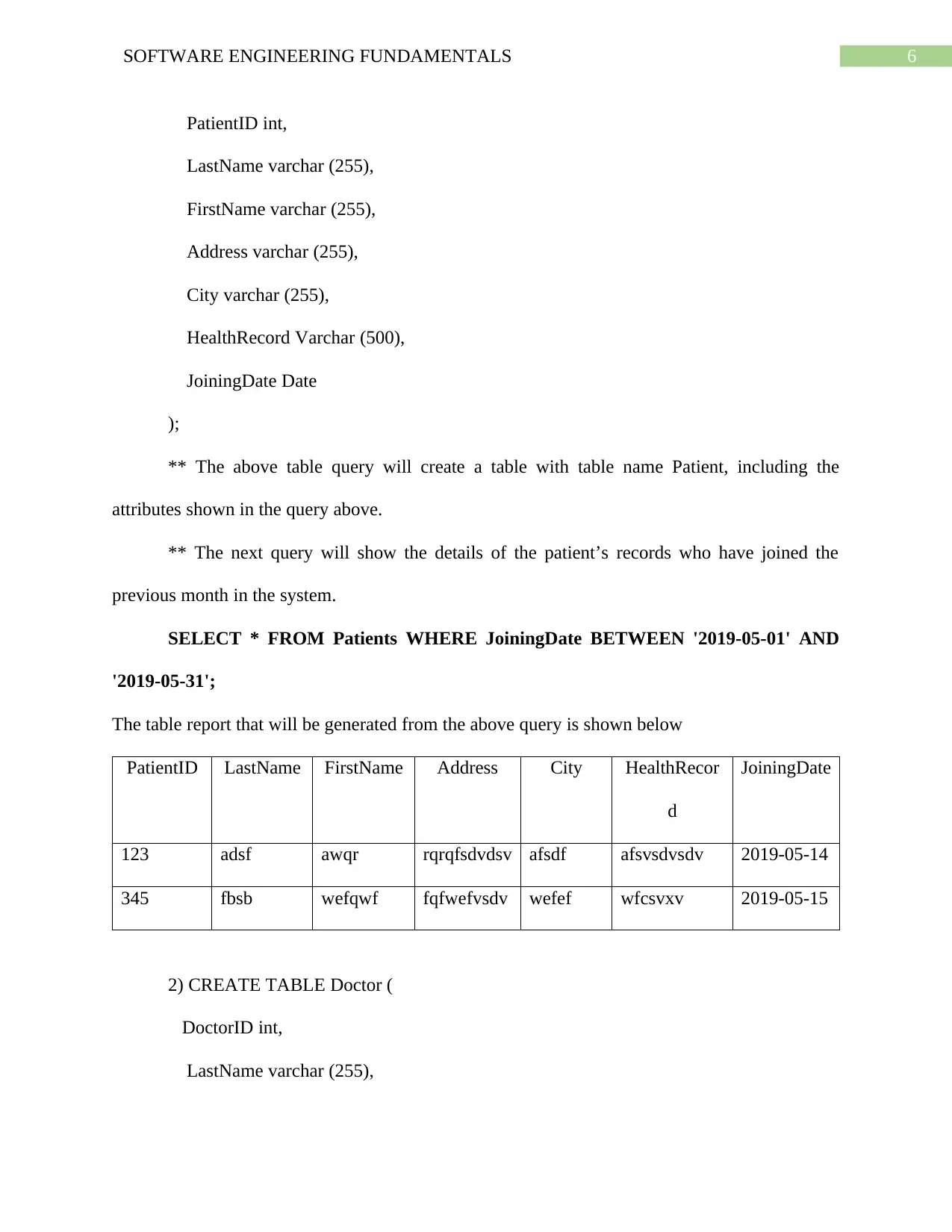
6SOFTWARE ENGINEERING FUNDAMENTALS
PatientID int,
LastName varchar (255),
FirstName varchar (255),
Address varchar (255),
City varchar (255),
HealthRecord Varchar (500),
JoiningDate Date
);
** The above table query will create a table with table name Patient, including the
attributes shown in the query above.
** The next query will show the details of the patient’s records who have joined the
previous month in the system.
SELECT * FROM Patients WHERE JoiningDate BETWEEN '2019-05-01' AND
'2019-05-31';
The table report that will be generated from the above query is shown below
PatientID LastName FirstName Address City HealthRecor
d
JoiningDate
123 adsf awqr rqrqfsdvdsv afsdf afsvsdvsdv 2019-05-14
345 fbsb wefqwf fqfwefvsdv wefef wfcsvxv 2019-05-15
2) CREATE TABLE Doctor (
DoctorID int,
LastName varchar (255),
PatientID int,
LastName varchar (255),
FirstName varchar (255),
Address varchar (255),
City varchar (255),
HealthRecord Varchar (500),
JoiningDate Date
);
** The above table query will create a table with table name Patient, including the
attributes shown in the query above.
** The next query will show the details of the patient’s records who have joined the
previous month in the system.
SELECT * FROM Patients WHERE JoiningDate BETWEEN '2019-05-01' AND
'2019-05-31';
The table report that will be generated from the above query is shown below
PatientID LastName FirstName Address City HealthRecor
d
JoiningDate
123 adsf awqr rqrqfsdvdsv afsdf afsvsdvsdv 2019-05-14
345 fbsb wefqwf fqfwefvsdv wefef wfcsvxv 2019-05-15
2) CREATE TABLE Doctor (
DoctorID int,
LastName varchar (255),
Paraphrase This Document
Need a fresh take? Get an instant paraphrase of this document with our AI Paraphraser
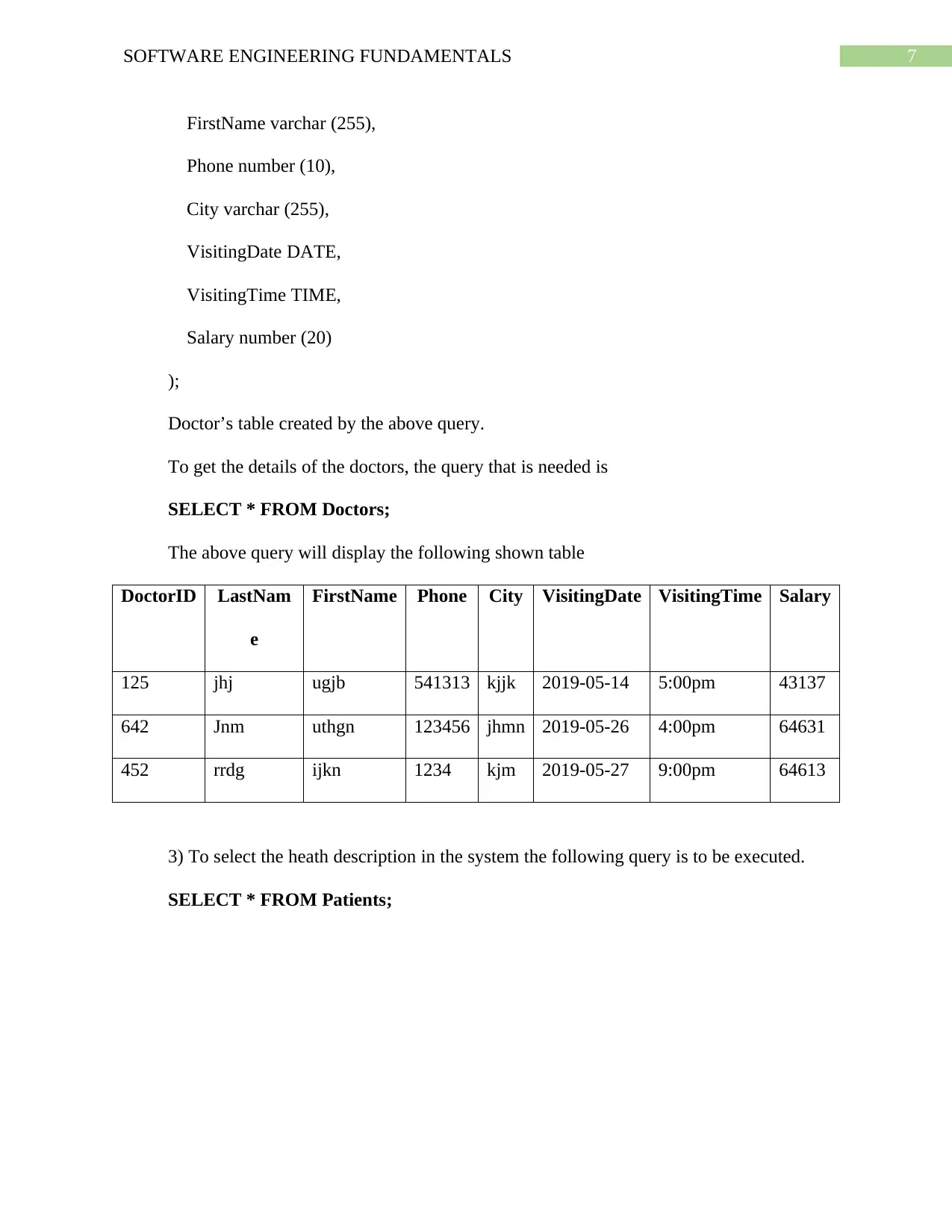
7SOFTWARE ENGINEERING FUNDAMENTALS
FirstName varchar (255),
Phone number (10),
City varchar (255),
VisitingDate DATE,
VisitingTime TIME,
Salary number (20)
);
Doctor’s table created by the above query.
To get the details of the doctors, the query that is needed is
SELECT * FROM Doctors;
The above query will display the following shown table
DoctorID LastNam
e
FirstName Phone City VisitingDate VisitingTime Salary
125 jhj ugjb 541313 kjjk 2019-05-14 5:00pm 43137
642 Jnm uthgn 123456 jhmn 2019-05-26 4:00pm 64631
452 rrdg ijkn 1234 kjm 2019-05-27 9:00pm 64613
3) To select the heath description in the system the following query is to be executed.
SELECT * FROM Patients;
FirstName varchar (255),
Phone number (10),
City varchar (255),
VisitingDate DATE,
VisitingTime TIME,
Salary number (20)
);
Doctor’s table created by the above query.
To get the details of the doctors, the query that is needed is
SELECT * FROM Doctors;
The above query will display the following shown table
DoctorID LastNam
e
FirstName Phone City VisitingDate VisitingTime Salary
125 jhj ugjb 541313 kjjk 2019-05-14 5:00pm 43137
642 Jnm uthgn 123456 jhmn 2019-05-26 4:00pm 64631
452 rrdg ijkn 1234 kjm 2019-05-27 9:00pm 64613
3) To select the heath description in the system the following query is to be executed.
SELECT * FROM Patients;
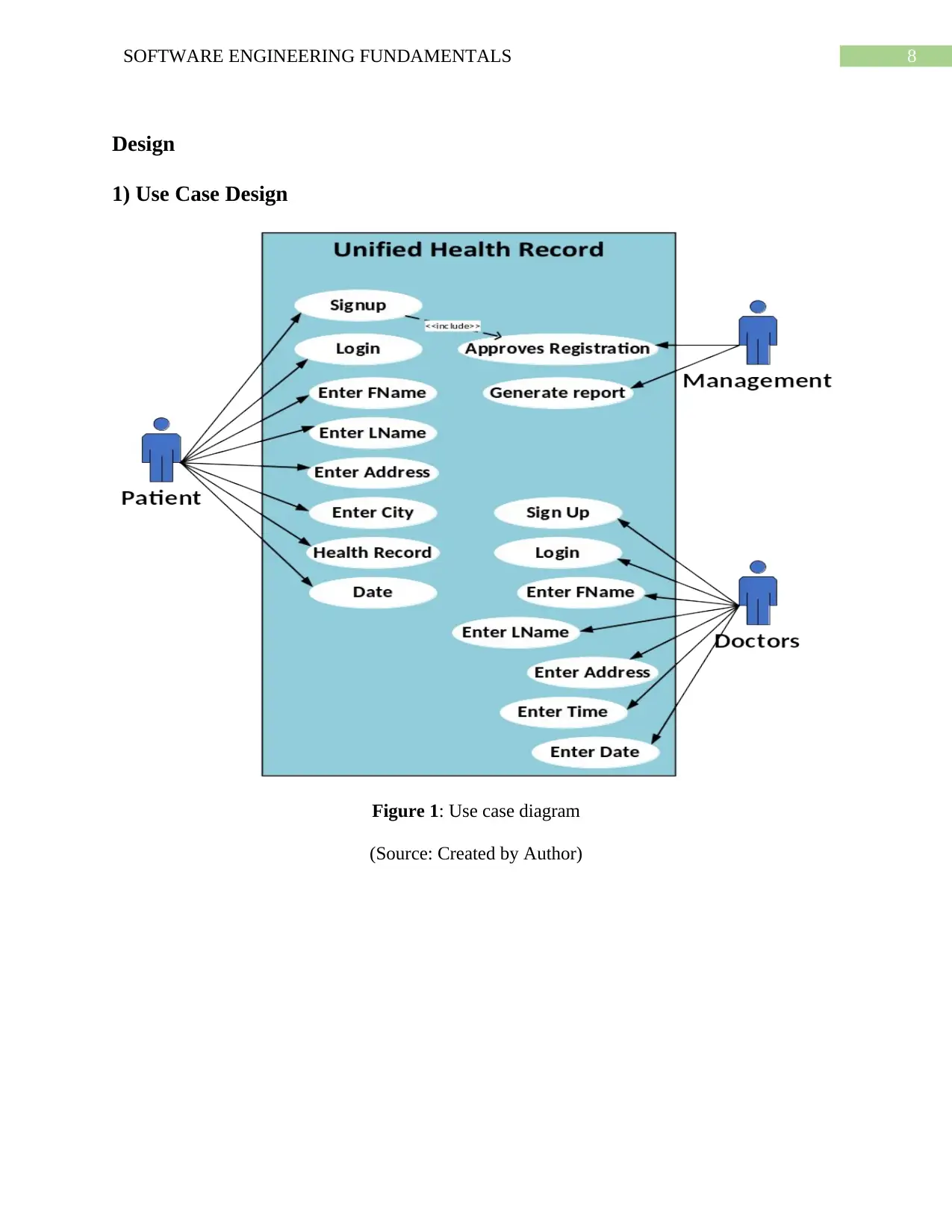
8SOFTWARE ENGINEERING FUNDAMENTALS
Design
1) Use Case Design
Figure 1: Use case diagram
(Source: Created by Author)
Design
1) Use Case Design
Figure 1: Use case diagram
(Source: Created by Author)
⊘ This is a preview!⊘
Do you want full access?
Subscribe today to unlock all pages.

Trusted by 1+ million students worldwide
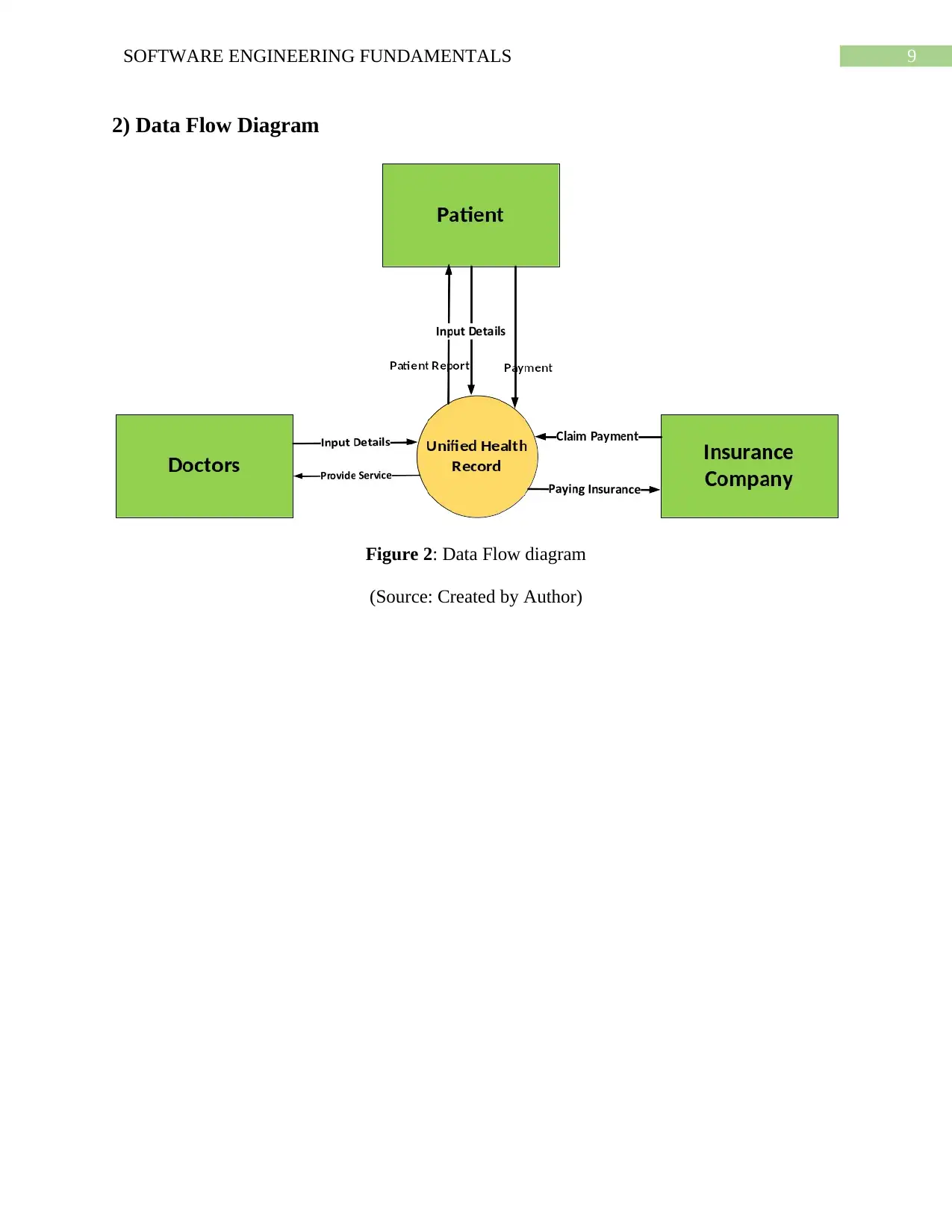
9SOFTWARE ENGINEERING FUNDAMENTALS
2) Data Flow Diagram
Figure 2: Data Flow diagram
(Source: Created by Author)
2) Data Flow Diagram
Figure 2: Data Flow diagram
(Source: Created by Author)
Paraphrase This Document
Need a fresh take? Get an instant paraphrase of this document with our AI Paraphraser
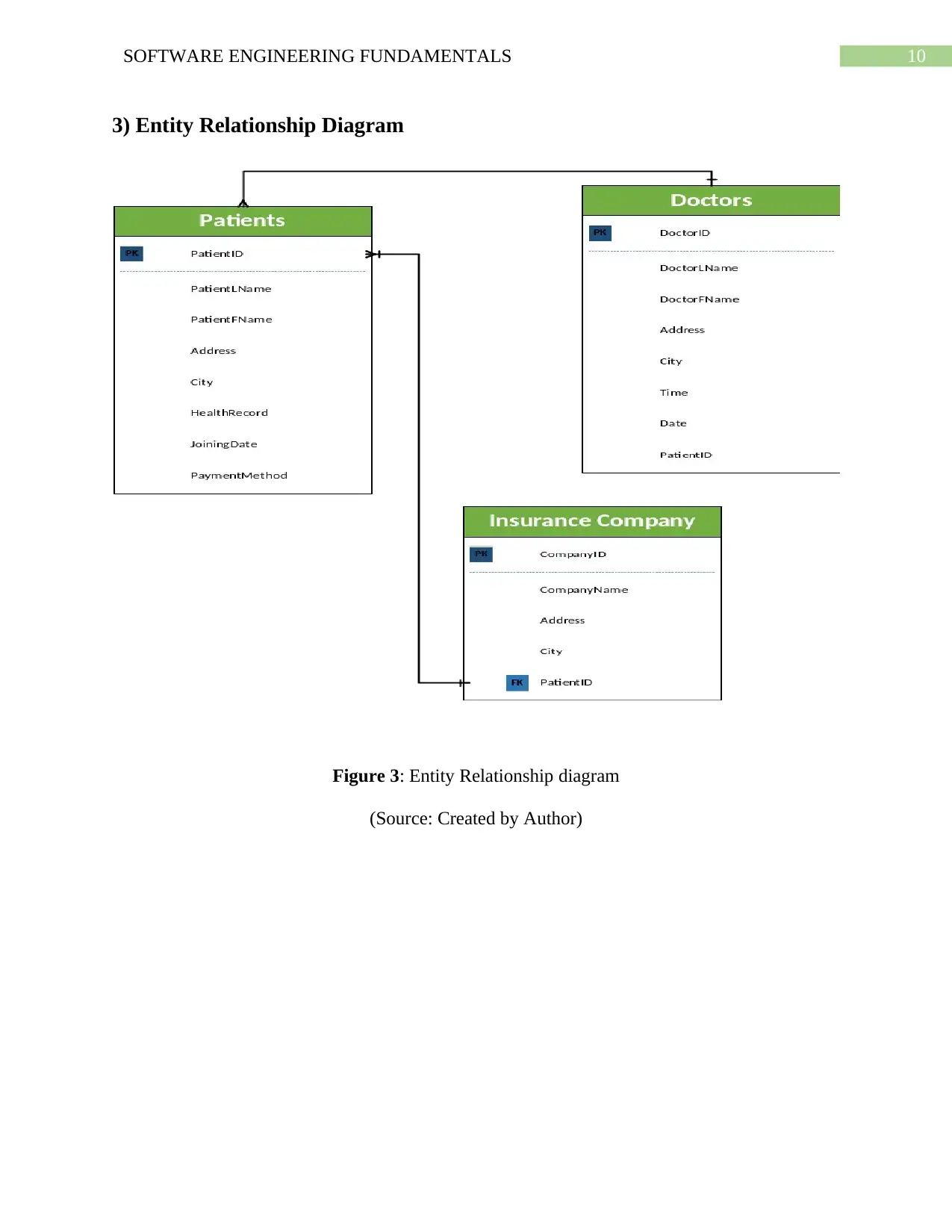
10SOFTWARE ENGINEERING FUNDAMENTALS
3) Entity Relationship Diagram
Figure 3: Entity Relationship diagram
(Source: Created by Author)
3) Entity Relationship Diagram
Figure 3: Entity Relationship diagram
(Source: Created by Author)
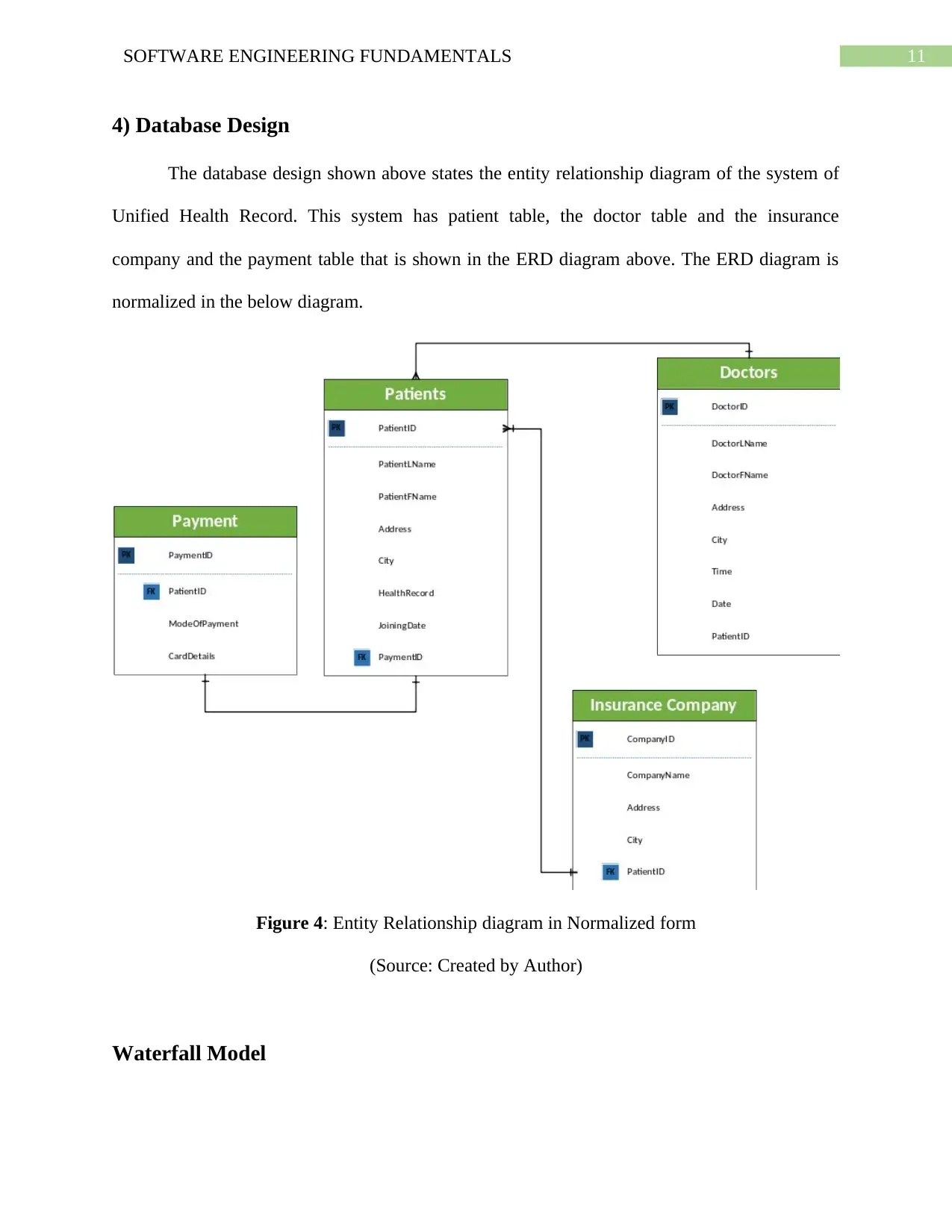
11SOFTWARE ENGINEERING FUNDAMENTALS
4) Database Design
The database design shown above states the entity relationship diagram of the system of
Unified Health Record. This system has patient table, the doctor table and the insurance
company and the payment table that is shown in the ERD diagram above. The ERD diagram is
normalized in the below diagram.
Figure 4: Entity Relationship diagram in Normalized form
(Source: Created by Author)
Waterfall Model
4) Database Design
The database design shown above states the entity relationship diagram of the system of
Unified Health Record. This system has patient table, the doctor table and the insurance
company and the payment table that is shown in the ERD diagram above. The ERD diagram is
normalized in the below diagram.
Figure 4: Entity Relationship diagram in Normalized form
(Source: Created by Author)
Waterfall Model
⊘ This is a preview!⊘
Do you want full access?
Subscribe today to unlock all pages.

Trusted by 1+ million students worldwide
1 out of 18
Related Documents
Your All-in-One AI-Powered Toolkit for Academic Success.
+13062052269
info@desklib.com
Available 24*7 on WhatsApp / Email
![[object Object]](/_next/static/media/star-bottom.7253800d.svg)
Unlock your academic potential
Copyright © 2020–2025 A2Z Services. All Rights Reserved. Developed and managed by ZUCOL.





